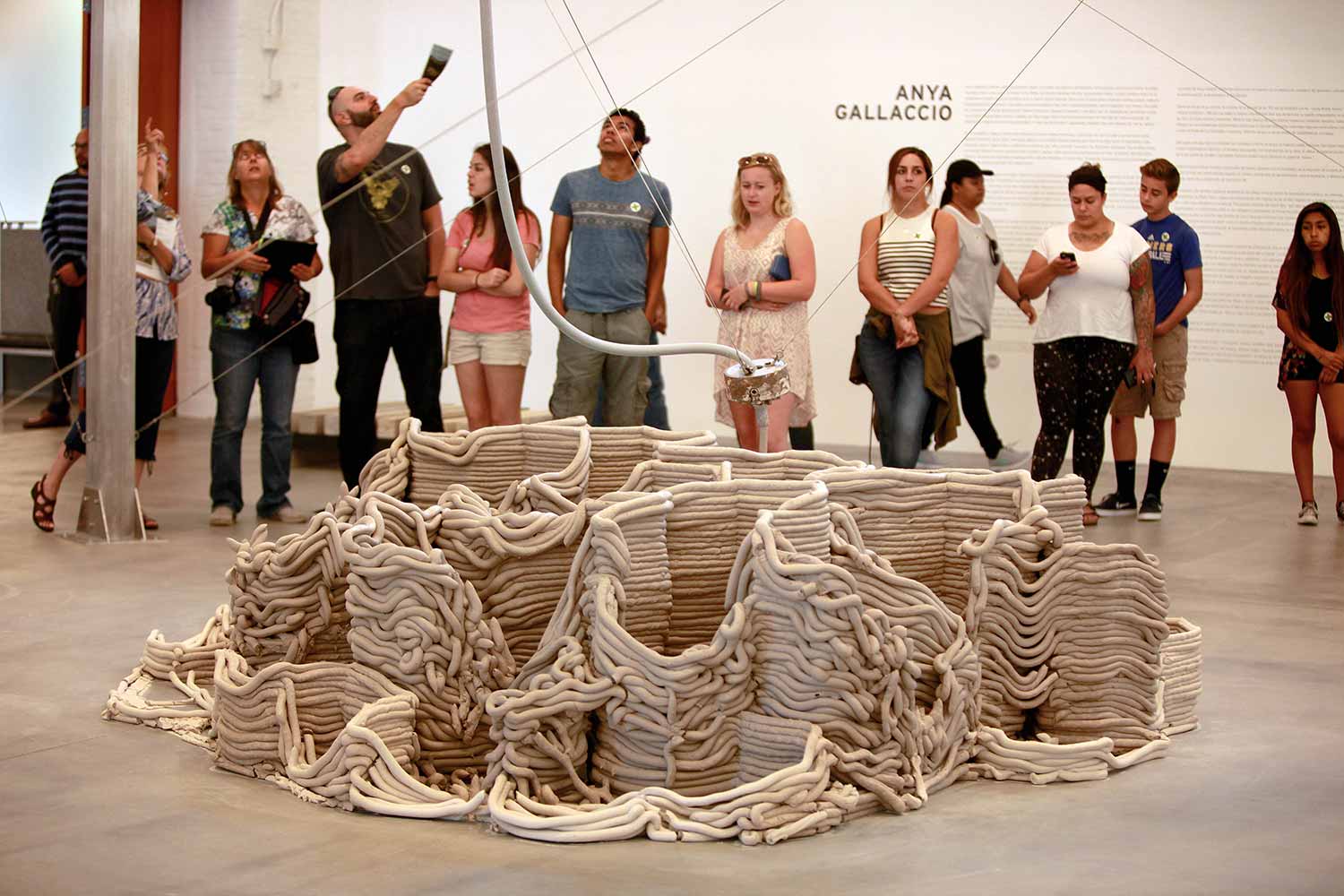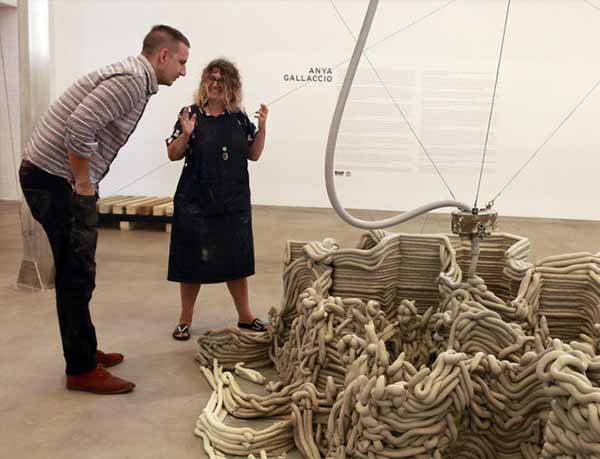By:
- Dirk Sutro
Published Date
By:
- Dirk Sutro
Share This:

MCASD visitors observe Gallacio’s sculpture grow steadily during the course of her solo exhibition. Photos by Giana Leone/Union Tribune
UC San Diego Visual Arts Professor Moves ‘Mountains’
Faculty-artist and her students combine art and technology to re-create Devil’s Tower
Clay oozes from a pump suspended by cables in a giant steel frame. Guided by computer software, the pump swings like a pendulum as it extrudes ropes of clay that will, over the course of days, pile up to form a sculpture modeled after Devil’s Tower, the Wyoming promontory once slapped together with mashed potatoes by Richard Dreyfuss in Close Encounters of the Third Kind.
The sculpture is the centerpiece of a solo show by Anya Gallaccio, the artist and UC San Diego visual arts professor whose innovative work will run through Nov. 1 at the downtown location of the Museum of Contemporary Art San Diego (MCASD). Her exhibition also includes a number of works loosely inspired by landscapes.
Since she joined UC San Diego’s Division of Arts and Humanities as a member of the visual arts faculty in 2008, Gallaccio has utilized technology, which she calls a “preoccupation” at the university. “I am interested in craft, and what that can mean, not in the literal sense of handicrafts, but ways of using both low and high technology, a tension between objective and subjective choices.”

Anya Gallacio with Visual Arts graduate program alumnus Joshua Miller (he welded the 3-D printer’s frame, helped Gallacio mix the recipe for the clay and built the mixer).
As her art has expanded to incorporate technology, Gallaccio’s project teams have grown much larger and more diverse. Managing the creative process can be complicated, and outcomes are unpredictable. Gallaccio must trust her collaborators, and they must place faith in her.
“I relinquished my quest for virtuosity a long time ago, developing my skills as a producer, as a director,” she said. “I work with highly skilled people, utilizing their expertise and trying to stretch the parameters of what they think is possible or appropriate. The collaborators are crucial, and the success of the work is dependent on trust and how far I have managed to push them.”
For this project, Gallaccio’ s team was led by UC San Diego visual arts graduate students Kyle Thompson and Joshua Miller, along with Kim Garcia and David Shere, both ICAM (Interdisciplinary Computing and the Arts) and studio majors from the Division of Arts and Humanities, plus three students from Woodbury University School of Architecture in San Diego. The students helped design and fabricate all elements of the project, building the metal structure, determining the recipe for the clay, pulling together the electronics and writing the code.
“I am not a conventional studio artist, and whilst I am always working there is often very little evidence of activity, which makes it difficult to share my process with my students,” she said. “Things just appear as if with no or little effort. It was a significant gesture of trust for my students to see me vulnerable and pushing onwards, not just settling on the first solution. As emerging artists, they were also made aware of obligations and expectations from the museum, and my galleries both here and in Europe who were financially involved.”
Gallaccio’s team also included art fabricators in Madrid and London and industrial types (the pump came from Italy, where it is mostly used for the production of olive oil and wine), along with artists and designers she met at a “Digital Clay” symposium at the California College of the Arts in San Francisco.
Technology has added a new twist, but at its core Gallaccio’s work remains centered on organic materials, natural phenomena and ideas about history and civilization. In earlier works, Gallaccio and various collaborators produced 400 cases of Zinfandel from six varieties of grapes in Sonoma, Calif.; placed a 32-ton block of ice inside a London gallery where it melted during her show’s two-month run; painted a Vienna gallery’s walls with chocolate and filled an abandoned French church with 10,000 roses that decomposed during the course of her exhibit.
Although fascinated with the desert and other raw locales, Gallaccio is not the sort of person who only feels comfortable in desolate places.
“I go a bit batty in the desert or the wilderness after a few hours,” she said. “I’m definitely a city girl, but trips into the landscape are essential to my process. To really understand a material you need to see where it lives.”
For her new piece, Gallaccio was intrigued by clay as an apt metaphor for the impact of growth and urbanization on San Diego. She and her team designed and built the new software-guided printer—it looks like something from an automobile assembly line, but it’s a printer in the sense that it defines a shape by generating a line.
Gallaccio explained that she has been thinking about lines in relation to the exhibition: the shoreline, the line of the border fence, the line of Interstate 5 that leads to LA, the Amtrak line, the line of mountains to the east. “The idea of lines made sense as a sort of iconic process to represent the impact over time of a city interrupting the natural order,” she said.
In Close Encounters, Dreyfuss’s character became obsessed with Devil’s Tower. In his mashed potato frenzy, he scared the heck out of his family and made an epic mess, but couldn’t stop himself. Gallaccio identifies with this compulsion to create, regardless of the consequences and in spite of not knowing the outcome.
“I like the absurdity of building a machine to print a mountain—an idealized version of something created in geologic time, and leaving the construction visible,” she said. “I like the idea of ‘moving’ Devil’s Tower to San Diego by printing it with clay from the region, a very analog process based in technology.”
“Anya Gallaccio” is on view at the Museum of Contemporary Art San Diego through Nov. 1, 2015. The museum is at 1100 and 1001 Kettner Blvd. in downtown San Diego. For more information: Anya Gallaccio; visarts.ucsd.edu.
Share This:
Stay in the Know
Keep up with all the latest from UC San Diego. Subscribe to the newsletter today.



